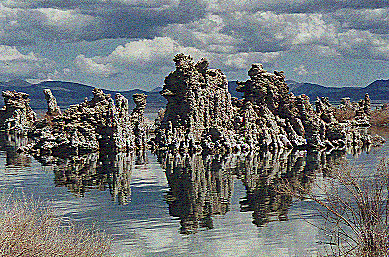|
Mysterious Mono Lake
Mono Lake is unique, it's over 700,000 years old and one of the oldest continuously existing lakes on the continent. Fed by huge glaciers back during the last Ice Age, Mono Lake was once 60 times larger than the 66 square miles it covers today. Mono Lake is naturally salty and alkaline because it has no outlet. The only way water leaves is via evaporation. Mono Lake is a geologist's paradise, ringed by volcanoes. Two of the islands on the lake are volcanic domes. Perhaps the most intriguing phenomena are the tufa towers visible along much of the shoreline. Tufa are made from calcium carbonate which makes its way into the lake from underground springs. Declining lake levels have exposed the tufa towers we see today. Some of these tufa towers are up to 30 feet high. Upon first glance, it would seem that Mono Lake is lifeless. Far from it, Mono supports a simple but amazingly productive food chain. The Mono Lake Committee Back to Sierra Gateway Map |
|
 At the bottom of the chain are algae. The algae serves as food for
two other species--brine shrimp and brine flies which, serve as the
major food source for millions of water birds. There
are at least 80 species of water fowl that call Mono Lake home.
Mono Lake and the adjacent basin are open for year-round recreation.
Hiking, swimming, bird watching and photography are very popular outdoor activities.
At the bottom of the chain are algae. The algae serves as food for
two other species--brine shrimp and brine flies which, serve as the
major food source for millions of water birds. There
are at least 80 species of water fowl that call Mono Lake home.
Mono Lake and the adjacent basin are open for year-round recreation.
Hiking, swimming, bird watching and photography are very popular outdoor activities.
|